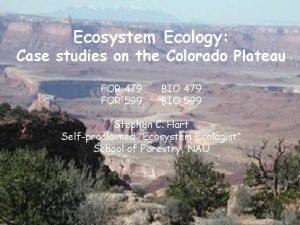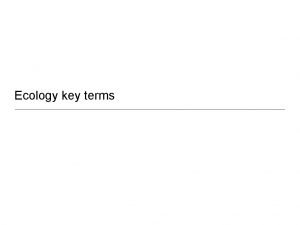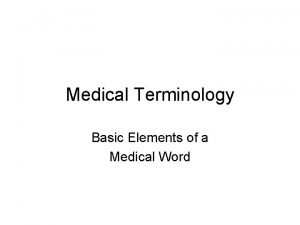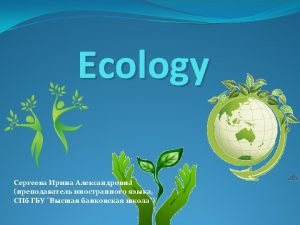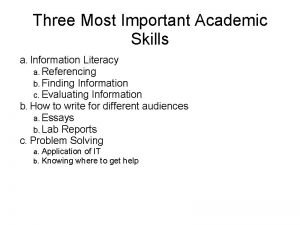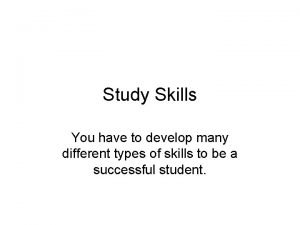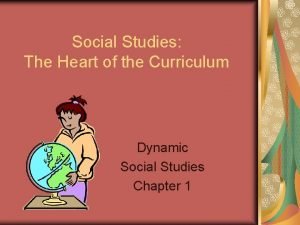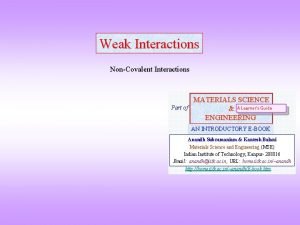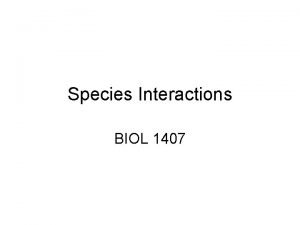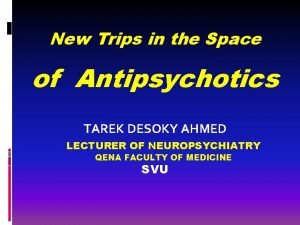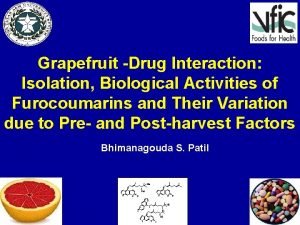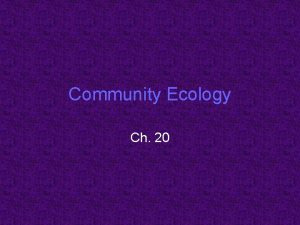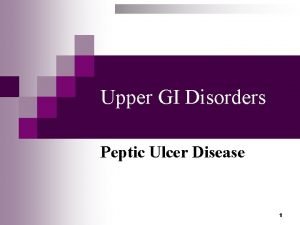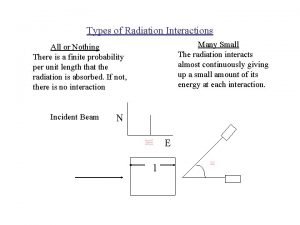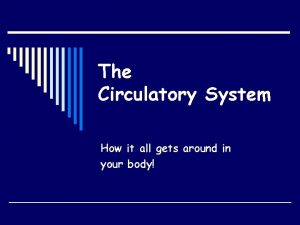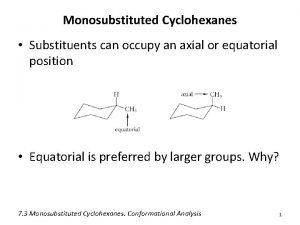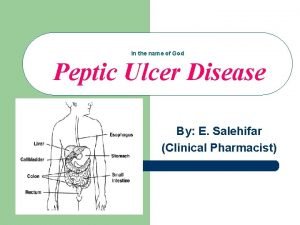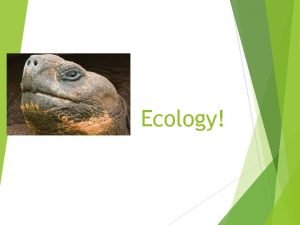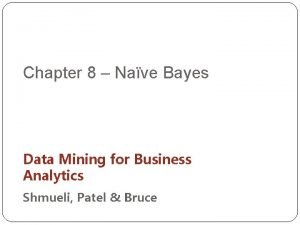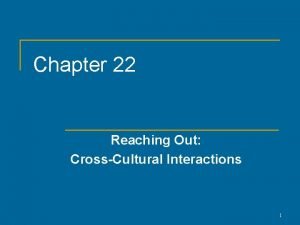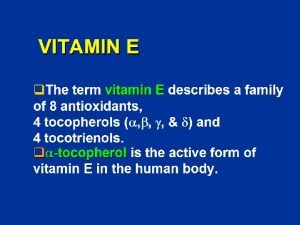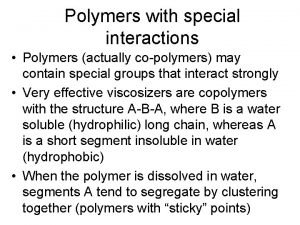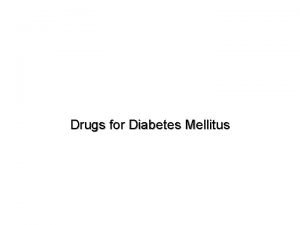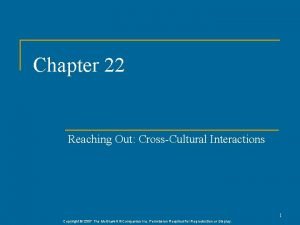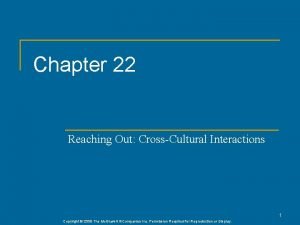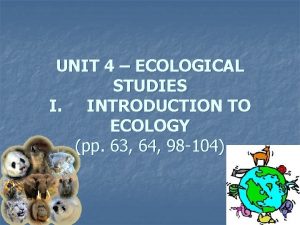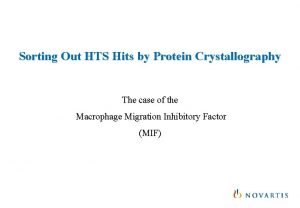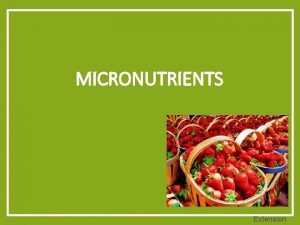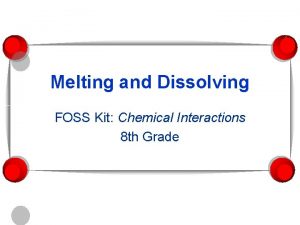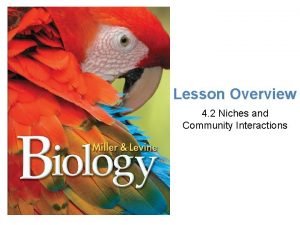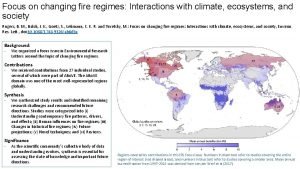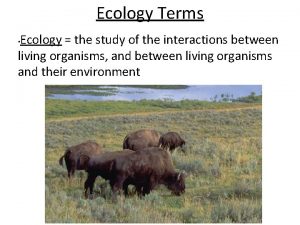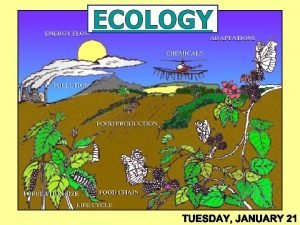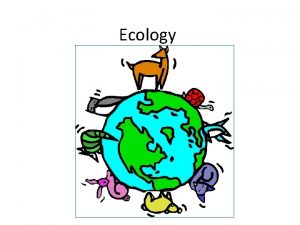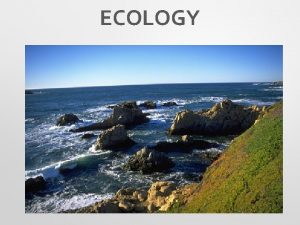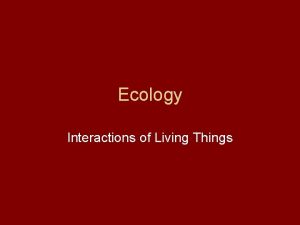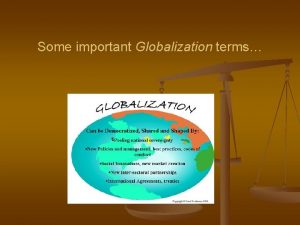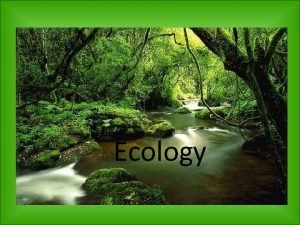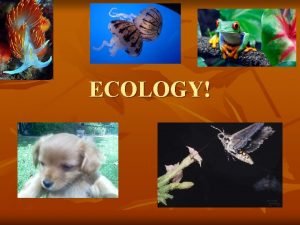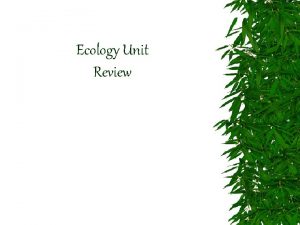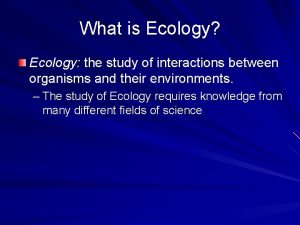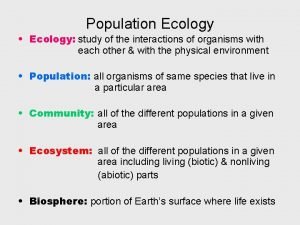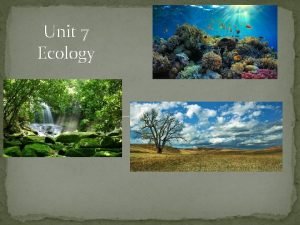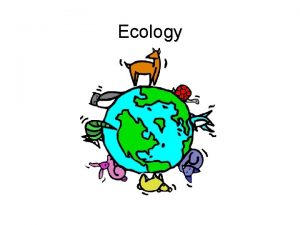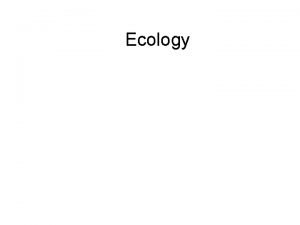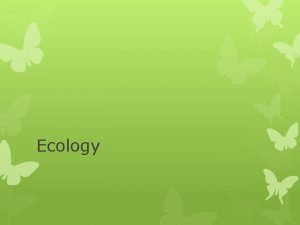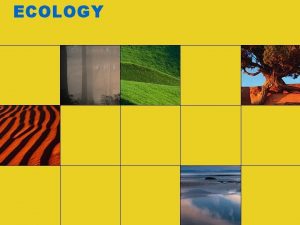Ecology Important terms Ecology study of interactions of






















































- Slides: 54

Ecology

Important terms: • Ecology- study of interactions of living organisms with one another and their environment • Environmental Science- study of the air, water, and land surrounding an organism or a community and human impact on the environment • Species-a group of organisms that are closely related and can mate and produce fertile offspring • Habitat-the place an organism usually lives; it’s home • Niche-the unique position occupied by a species, both in terms of its physical use of its habitat and its function within an ecological community; its role Ex: lions are carnivorous predators

I. Animal Relationships A. Producer/Autotrophs 1. Producers (autotrophs): organisms that can use energy directly from the sun to produce simple sugars (glucose) that other organisms can use for food a. The sun is the ultimate source for most life on earth b. Less than 1% of the suns energy that reaches the earth is used by living organisms


2. Do not have to eat other organisms to survive Ex: plants, algae, some protists, some bacteria **The equation for photosynthesis: CO 2 +H 2 O+light C 6 H 12 O 6+O 2 Carbon dioxide gas + water + light gives you Glucose sugar + oxygen gas

Consumers/Heterotrophs 1. Get energy by eating (consuming) food either plant or animals and therefore must depend on other organisms for food 2. Get energy through the process of cellular respiration C 6 H 12 O 6+O 2 CO 2+H 2 O+ATP Glucose sugar + oxygen gas Gives you Carbon dioxide gas + water+ energy 3. Consumers that eat producers are considered to be primary consumers since they are the primary (first) things to eat in the food chain. 4. When you eat the cow you are then a secondary consumer since you are the second thing that eats. Ex: some protists, all fungi and animals


Decomposers and Detrivores • • • Both are consumers since they don’t make their own food Decomposers break down dead organisms into matter called detritus. Detritus- non-living particulate organic matter (as opposed to dissolved organic material). It typically includes the bodies or fragments of dead organisms as well as fecal material Detrivores convert the detritus (organic matter) into inorganic matter like nitrogen which plants need to survive Ex: earthworms, neamtodes, most bacteria, some protists


Plant-Herbivore • Herbivore: an animal that eats producers Ex: Cows eating grass • Herbivores usually have special adaptations to chew and digest their food Ex: Cows have large molar teeth designed to chew grass and break down cellulose; they also have special bacteria that help them to digest their food; most have longer digestive systems since plants take longer to digest • Plants have adaptations like thorns and poisons to keep herbivores from eating them


Ecosystem organization Organism • An individual living thing • Ex: mouse Population • Organisms of the same species live in the same place • Ex: group of mice in a field Community • All the different species that live in the same place ant the same time • Biotic factors: Living things in the environment (plants, animals, fungi, bacteria, protists) • Ex: Field of grass, field mice, earthworms, insects, lizards, etc

Ecosystem • All the living organisms (biotic factors) and their environment such as rocks, soil, etc. • abiotic factors: Non-living parts of the environment (water, rocks, soil, sunlight) Biosphere • All the ecosystems in the world; the portion of earth where living organisms can survive • Ex: Earth


• Keystone species- species that is critical to the functioning of an ecosystem that it lives in • It affects the survival and abundance of many other species in its community • Ex: Sea otters keep the sea urchins in check from eating too much kelp. When sea otters died more sea urchins ate more kelp which decreased kelp.

Food Chains and Food Webs • Food chain: a simple explanation for the flow of energy from autotrophs to heterotrophs to decomposers • Food chains don’t show the natural flow of energy in an ecosystem so food webs are used


• Food webs are dependent upon each other. What would happen if to rabbit population if the grass population was wiped out? Decrease in size • If the rabbit and mouse population declined, what would happen to the owls? Decline and foxes? Decline • What would happen to the rabbit population if the rainfall increased? Increase • If the rabbit population increased, what would happen to the owl population? Increase • If there are more producers, then the first level consumers increase; if they increase, then the secondary consumers would increase • Top consumer (apex predator) : animal at end of food chain/web with no natural predators; usually a carnivore • Producers, primary consumer, secondary consumer, tertiary consumer, quarternary consumer

Ecological Pyramids • Pyramid of Energy: Shows how energy is transferred through each trophic level • Trophic Level: Each step in a food web or food chain; each trophic level indicates how many times energy has been transferred • First trophic level: producers, next trophic level is heterotrophs • Energy Pyramid : Shows how energy is transferred through each trophic level; Only 10% of the energy at each level is transferred to the next higher level the rest of the energy is lost as heat • Producers have the most energy and top consumers or decomposers have the lowest amount of energy • Energy is not recycled it is lost


Pyramid of Biomass and Numbers • Biomass: Mass of dry organic material in an organism (putting things on a big imaginary scale. • Shows the amount of living (organic, must contain carbon) material in a given trophic level; biomass decreases as you move up the pyramid. • Usually expressed in kilograms per unit area • Producers usually have the highest biomass and top consumers usually have the least amount


Pyramid of Numbers • Shows the approximate number of individual organisms at each level that an ecosystem can support (instead of grams, its numbers) • Unlike the biomass pyramid, the producers are not ALWAYS the most numerous.


Biogeochemical Cycles • Remember CHON carbon, hydrogen, oxygen, and nitrogen make up the majority of living things • These elements are cycled in the biosphere (Earth) • Biogeochemical cycle: chemicals moving through both living (biotic) and geological (abiotic) parts of the ecosystem • Unlike energy which flows only one way, chemicals can be recycled through the biosphere and reused.

The Water Cycle • Shows how water moves from the atmosphere to the ground, and then back into the atmosphere again. • Precipitation: how water gets from the atmosphere to the ground; rain, snow, sleet, or any water form from the atmosphere • Evaporation: Water moving to the atmosphere from lakes, rivers, streams, and other bodies of water. It is called water vapor • Transpiration: Plants giving off water • If water sinks into the ground it is called ground water • Condensation: water vapor condenses and forms clouds, when clouds get too heavy to hold any more water vapor, precipitation occurs



The Carbon Cycle • Remember carbon is found in ALL living things • Most carbon in the atmosphere is in the form of carbon dioxide • Photosynthesis changes the carbon dioxide into organic molecules (glucose). • The producers use some of this glucose to grow and carry out life processes. • Consumers eat the producer they use the glucose made by plants for energy through cellular respiration • Combustion: burning fuels releasing carbon dioxide • Carbon fixation: converting inorganic carbon (carbon dioxide) into organic carbon (sugars)

• Cellular Respiration changes these organic compounds back into carbon dioxide (what you breathe out) • Decomposers break down molecules and release more CO 2 into the atmosphere • When an organism dies some of the carbon is trapped. The organism may decompose or become fossil fuels (oil, gas, coal, wood, paper) • When these fossil is burned (burning wood, oil) the CO 2 is released back into the atmosphere • Plants absorb this CO 2 and the process starts over


Oxygen Cycle • During photosynthesis water molecules are split and releases oxygen into the air as a byproduct • Oxygen is taken by organisms during cellular respiration. • Some oxygen is found in the ozone. – It has 3 oxygen atoms. – It is harmful to breathe – it is needed in the upper atmosphere to help shield earth from harmful UV rays


• The carbon and oxygen cycles work together through photosynthesis and cellular respiration. – Cellular respiration takes in O 2 and releases CO 2 – Photosynthesis releases O 2 and takes in CO 2

The Nitrogen Cycle • Nitrogen is used to make amino acids (amino acids build proteins) • Nitrogen makes up 78% of the earth’s atmosphere; most organisms can not use this form of nitrogen • Some bacteria live on the nodules on the roots of some plants and in the soil • These bacteria take in nitrogen gas, (N 2) and covert it to ammonia (NH 3) This is called nitrogen fixation. • Eutrophication: depletion of oxygen in water, can occur when chemical nutrients cause overgrowth of algae and aquatic plants

• Other bacteria then change ammonia into nitrates (NO 3 -) and nitrites (NO 2 -). This process is called nitrification. • Plants use the nitrites and nitrates formed by bacteria to make proteins. • Consumers eat plants and the nitrogen is reused to make protein in the consumer. – Human activities fertilizing their yard put nitrogen back into the soil for the bacteria to break down. • Waste products of animals or animals dying puts ammonia, nitrates, and nitrites back into the soil. – Some bacteria break down dead bodies and waste products are broken down into usable forms by plants – Other bacteria change the nitrates in the soil back into gas. • This process is called denitrification. • Nitrogen found in oceans is put back into the atmosphere through denitrification.


Phosphorous cycle: • Phosphate is found in DNA, RNA, and ATP and is part of the cell membrane phospholipids. • Phosphorous does not enter the atmosphere but is cycled between living and nonliving parts of an ecosystem through rocks, soil, water, and living things • They can be dissolved into water, then found in soil after rocks are weathered. Plants then convert phosphate from the soil into organic phosphate, then animals eat it. It returns to the soil when plants and animals die • Excess phosphate can also cause eutrophication

Human Impact • Natural Population Growth – Follows an S-shaped curve – Logistic growth

• A new population in an ecosystem will grow slowly at first and then more quickly since there will be unlimited resources. • When the population levels off, it has reached carrying capacity • Carrying capacity: the largest number of organisms the environment will support. • As long as the birth/death rate and immigration/emigration rates are the same the organisms could live at carrying capacity. • This rarely happens therefore populations are limited by limiting factors. • Limiting Factors: Factors that limit the population growth • food • water • habitat

• Population density: number of individuals living in an area at one time • Density dependent factors: limiting factors that depend on the number of organisms in a population Ex: food, water, habitat, shelter • Density independent factors: limiting factors that do not depend on the number of organisms in a population Ex: natural disasters and human activities

• Population dispersion: the way individuals spread out in an area • Clumped dispersion: live in groups where large numbers help for safety, food, mating • Uniform dispersion: evenly spaced apart to decrease competition • Random dispersion: randomly spread out since their lifestyle is independent from others and competition is not a struggle


Unrestricted Population Growth • When a non-native species is introduced into an ecosystem, it normally has few or no natural predators and has plenty of food. • This causes the J-shaped curve • Exponential growth • Ex: Two dozen rabbits were introduced into Australia in the 1800’s. They had no natural predators and unlimited food so they overpopulated. They multiplied quickly and now hunters can shoot 1200 rabbits a day and it would make no difference. They wiped out the plant population causing the extinction of 1/8 th of the mammal species.


Ecological Succession • Ecosystems are always changing. – These changes may result from natural causes like weather or volcanoes or from human actions like strip mining. • Ecological Succession: A series of predictable changes in an ecosystem.

Primary Succession • • Primary means first. This succession starts where there is no soil. Occurs after disturbances such as volcano eruptions Pioneer species are the first things to grow in this area ex: lichens – Lichens can form on bare rock and over time turn the rock into soil. • As soil accumulates smaller animals such as worms and grasses can be found here. – These small animals give way to shrubs and birds which give way to trees and larger mammals.


Secondary Succession • Occurs when something has existed there before such as after a forest fire. – it is known as the second community • The soil is not removed and usually seeds are present in the soil. – The community is not starting from scratch.

Climax Community • The final community of organisms • Hardwoods such as maples and oaks are found here • Changes little but are still affected by nonnative species • Secondary succession takes less time to reach a climax community than primary succession.


Succession in a pond • Never reach climax communities • Water plants begin to grow • sediment falls into the pond and the plant’s roots anchor the soil • Sediment will continue to fall in until the pond if filled in with soil which will eventually lead to grasses and trees


 Ecology and ecosystem
Ecology and ecosystem Ecology key terms
Ecology key terms Like terms and unlike terms in polynomials
Like terms and unlike terms in polynomials Identifying like terms
Identifying like terms Anatomy directional terms
Anatomy directional terms The element at the beginning of a medical term is known as
The element at the beginning of a medical term is known as Newspaper article format
Newspaper article format Inverted pyramid in news writing
Inverted pyramid in news writing Least important to most important
Least important to most important Biology ecology study guide answer key
Biology ecology study guide answer key Chapter 3, section 1: community ecology answer key
Chapter 3, section 1: community ecology answer key Ecology is the study that helps to preserve
Ecology is the study that helps to preserve What are study skills and why are they important
What are study skills and why are they important What are study skills and why are they important
What are study skills and why are they important What is social studies and why is it important
What is social studies and why is it important Noncovalent interactions
Noncovalent interactions Congress formal and informal powers
Congress formal and informal powers Adelphoparasitism
Adelphoparasitism Example of commensalism
Example of commensalism Qualitative and quantitative variables
Qualitative and quantitative variables Sertraline interactions
Sertraline interactions Loanable funds graph recession
Loanable funds graph recession Properties and interactions of magnets
Properties and interactions of magnets Felodapine
Felodapine Interactions within ecosystems grade 7
Interactions within ecosystems grade 7 Abiotic components
Abiotic components Humans built a dam out of rock materials
Humans built a dam out of rock materials Section 20-1 review species interactions
Section 20-1 review species interactions Plants called sundews have rounded green leaves
Plants called sundews have rounded green leaves 6.1 niches and community interactions answers
6.1 niches and community interactions answers Ppi omeprazole
Ppi omeprazole Types of interactions
Types of interactions Circulatory system interactions with other systems
Circulatory system interactions with other systems What is product architecture
What is product architecture Axial substituents
Axial substituents Diazepam cyp450
Diazepam cyp450 Factors affecting communication skills
Factors affecting communication skills Symbiosis and species interactions keystone webquest
Symbiosis and species interactions keystone webquest Function of digestive tract
Function of digestive tract Naive bayes pays attention to complex interactions and
Naive bayes pays attention to complex interactions and Chapter 22 reaching out cross-cultural interactions
Chapter 22 reaching out cross-cultural interactions Beri beri
Beri beri Fundamental and incidental interactions
Fundamental and incidental interactions Special interactions
Special interactions Cholinomimetic
Cholinomimetic Chapter 22 reaching out cross-cultural interactions
Chapter 22 reaching out cross-cultural interactions Chapter 22 reaching out cross-cultural interactions
Chapter 22 reaching out cross-cultural interactions Accounting information system chapter 1
Accounting information system chapter 1 Unit 5 ecology
Unit 5 ecology Ecosystems interactions
Ecosystems interactions Hccee
Hccee Nutrient interactions
Nutrient interactions Foss chemical interactions
Foss chemical interactions Niches and community interactions
Niches and community interactions Interactions
Interactions
